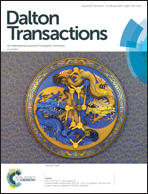Synthesis and antiproliferative activity of a series of new platinum and palladium diphosphane complexes†
Abstract
New organometallic complexes [M(dppe)(R)2] {where M = Pt or Pd, dppe = 1,2-bis(diphenylphosphano)ethane, and R = C6F4H-x (x = 6,5,4), C6F3H2-3,5, C6F3H2-5,6, C6F3H2-3,6, C6F4(OMe)-4, and C6F4(cyclo-C5H10N)-4, the numbers x refer to the positions of the protons in the polyfluoroaryl ligands} were synthesised either through transmetalation from the dichlorido complexes [M(dppe)Cl2] or through ligand exchange using [M(diene)Cl2] precursor complexes with diene = 1,5-cyclooctadiene (cod) or 1,5-hexadiene (hex). Alternatively, [M(dppX)Cl(R)] complexes with dppX = dppm (1,1-bis(diphenylphosphano)methane), dppe, dppp (1,3-bis(diphenylphosphano)propane), and dppb (1,4-bis(diphenylphosphano)butane) were prepared in decarboxylation reactions from thallium(I) carboxylates Tl(O2CR). The different preparative methods were compared in terms of yield and purity. Structural and spectroscopic data are reported for the new dppX- and diene-M(R)2 complexes. Antiproliferative activity was investigated for these new complexes against the HT-29 (colon carcinoma) and MCF-7 (breast adenocarcinoma) cell lines, and the active compounds of this first series together with organometallic dppX or hex PtII or PdII complexes were then included in cell tests using L1210 (leukaemia cells) and the cisplatin-resistant L1210/DDP cell line. Remarkably, promising antiproliferative results were found for a few PtII and PdII complexes, while structurally closely related compounds were essentially nontoxic.



 Please wait while we load your content...
Please wait while we load your content...